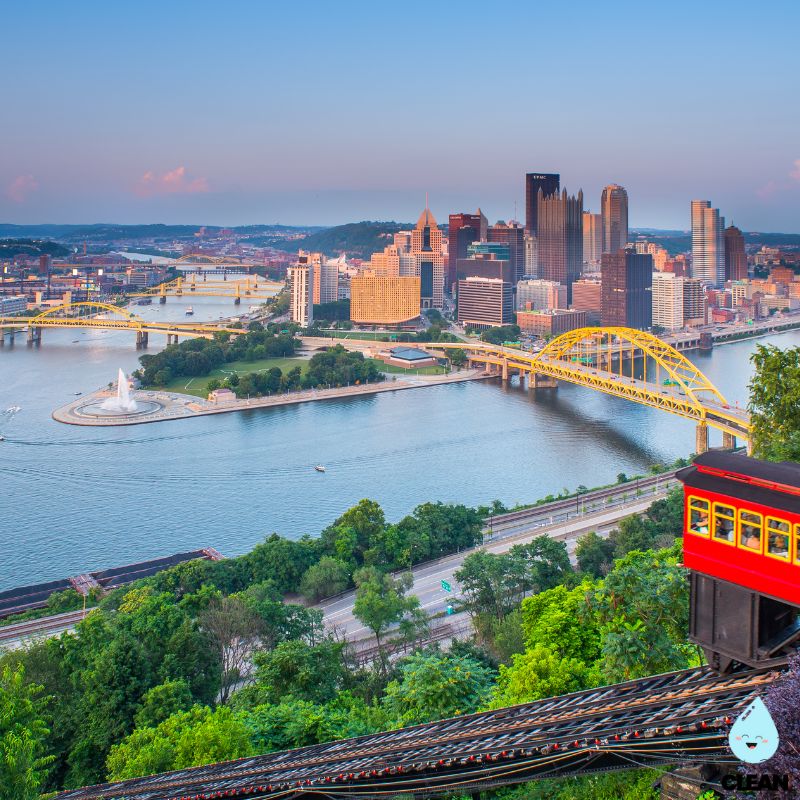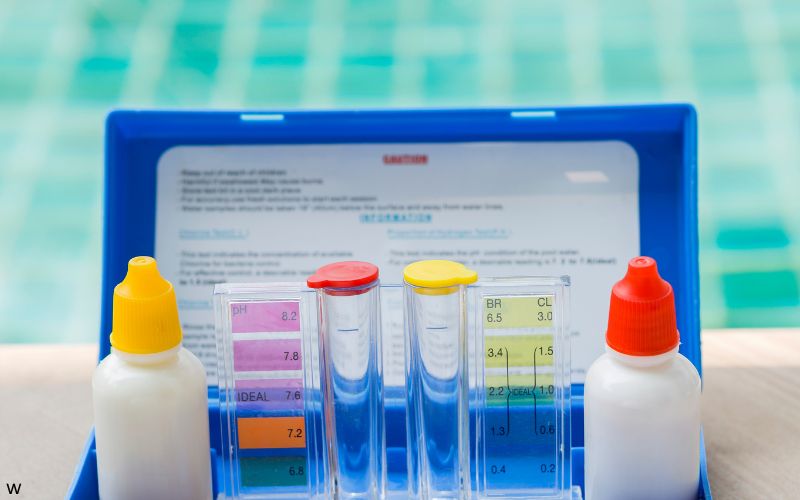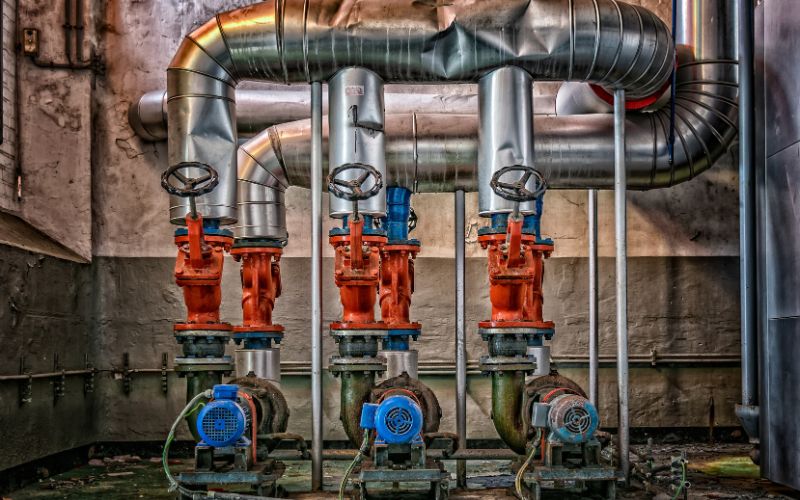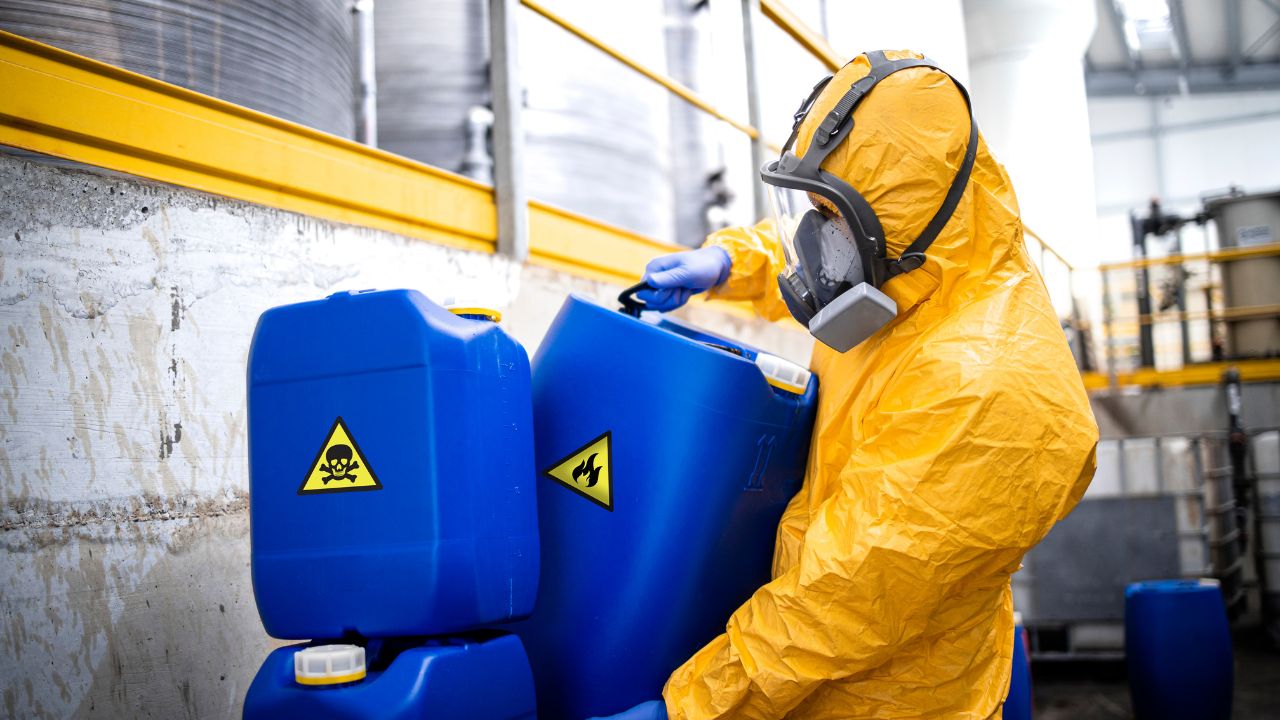Pittsburgh Water Quality at a Glance
multiple contaminants
Is Pittsburgh Water Safe to Drink?
Compliant But Concerning – Pittsburgh water meets all federal standards and has dramatically improved lead levels to 3.6 ppb (20-year low). However, the city’s water contains chromium-6 at 27x health guidelines and multiple disinfection byproducts including chloroform, bromodichloromethane, and trihalomethanes. The Allegheny River source water is susceptible to industrial pollution and agricultural runoff from its drainage basin.
⚠️ Key Concerns for Pittsburgh Residents
- Chromium-6 (Hexavalent Chromium): 535 parts per trillion detected – 27x higher than EWG health guidelines; linked to cancer and reproductive harm
- Disinfection Byproducts: High levels of chloroform, bromodichloromethane, and trihalomethanes from chlorine treatment; linked to bladder and colon cancer
- Industrial Legacy: Pittsburgh’s industrial history and location at three rivers creates ongoing contamination risks from metals and chemical runoff
- PFAS Monitoring: While compliant now, ongoing monitoring needed as “forever chemicals” detected in regional wastewater and surface waters
Read the full report below for detailed analysis, city-specific data, and actionable recommendations for Pittsburgh residents.
Pittsburgh – Pennsylvania – Water Quality Report 2025: PFAS Testing, Infrastructure Concerns & Safety across your city
Pittsburgh Water (formerly PWSA) serves over 500,000 residents across the Pittsburgh region through a water system that includes approximately 930 miles of water mains, one primary water treatment plant, and multiple pumping and storage facilities. The system delivers roughly 65 million gallons daily from the Allegheny River, which serves as the primary water source for the city.
Pittsburgh draws its drinking water primarily from the Allegheny River through its main treatment plant located in Aspinwall. The city’s water system has undergone significant transformation since the 2016-2018 lead crisis, implementing comprehensive infrastructure investments and operational improvements. Since 2016, Pittsburgh Water has implemented major upgrades including an aggressive lead service line replacement program, optimized orthophosphate corrosion control, and enhanced monitoring systems. The authority’s commitment to transformation focuses on both water quality improvements and community engagement, addressing the legacy challenges of aging infrastructure while meeting modern water quality standards and rebuilding public trust.

Pittsburgh Water Quality: Current Status (2024-2025)
Latest Testing Results
- Lead Levels: The most recent testing period (2024) showed 90th percentile lead levels of 3.6 parts per billion (ppb), well below the EPA action level of 15 ppb, representing a 20-year low following optimized corrosion control and aggressive service line replacements.
- Testing Scope: Pittsburgh Water conducts comprehensive water quality testing including enhanced lead monitoring at high-risk residential sites and comprehensive testing at the main treatment facility.
- Compliance Status: Pittsburgh’s water meets all federal and state drinking water standards, with ongoing improvements and full PFAS compliance below EPA action levels.
Allegheny River Water Supply
- Primary Source: Allegheny River serves as the main water source, providing generally good water quality with consistent characteristics year-round.
- Treatment Plant: Single main water treatment plant located at 900 Freeport Road in Aspinwall processes up to 100 million gallons per day.
- Source Water Protection: The Allegheny River watershed is monitored for potential contamination from road deicing materials, railroad spills, and industrial activities.
Treatment Modernization
- Enhanced Coagulation: Upgraded chemical treatment processes using ferric chloride, potassium permanganate, and polymer to improve removal of organic compounds and particles.
- Corrosion Control: Optimized orthophosphate dosing system implemented since 2019 to create protective barriers in lead service lines and minimize lead leaching.
- Advanced Monitoring: Real-time water quality monitoring throughout the distribution system with regular testing for lead, PFAS, and disinfection byproducts.
Lead Service Line Initiative
- Replacement Progress: Over 12,000 lead service lines replaced since 2016, with both public and private lines replaced at no cost to homeowners.
- Lead Service Line Inventory: Comprehensive mapping identified approximately 25,000 confirmed or suspected lead service lines throughout the system at program start.
- Target Completion: Program aims to eliminate all lead service lines by 2027, with current replacement rate of 1,000-1,500 lines annually.
Community Engagement and Transparency
Pittsburgh Water has transformed its approach to community engagement following the 2016-2018 lead in water crisis, implementing extensive outreach programs, public meetings, and proactive customer notifications. The authority provides free water testing, filter distribution, and educational resources while maintaining transparency through water quality dashboards and detailed compliance reporting. Pittsburgh’s water improvement journey demonstrates how utilities can rebuild public trust through accountability, significant infrastructure investment, and sustained community engagement while addressing the complex challenges of aging water infrastructure in a post-industrial city.
Recommendations for Pittsburgh Residents

Request Line Replacement
Check if your property has a lead service line using Pittsburgh Water’s online lookup tool at pgh2o.com/lead. Apply for free lead service line replacement if your property is identified as having lead connections.

Get Free Filters
Pittsburgh Water provides free NSF-certified water filters to residents upon request. Order filters online at pgh2o.com or call customer service at 412-255-2423 to have them delivered to your home.

Test Your Water
Schedule free water testing through Pittsburgh Water by calling 412-255-2423 or visiting pgh2o.com. Testing is especially important for homes with children, pregnant women, or known lead service lines.

Flush Before Use
If water has been sitting in pipes for 6+ hours, run cold water for 2-3 minutes before drinking or cooking. Always use cold water for consumption to minimize potential lead exposure.

Stay Informed
Sign up for Pittsburgh Water alerts at pgh2o.com to receive water quality notifications, maintenance updates, and service interruption notices. Review monthly water quality reports and attend public meetings for updates.
Quality News About Your Water
Get the comprehensive water quality news coverage you need with our dedicated US Water News Service. From coast to coast, we deliver in-depth reporting and expert analysis on PFAS contamination, EPA regulatory changes, infrastructure developments, and emerging water safety issues affecting communities nationwide. While mainstream media only covers the biggest stories, we provide the detailed, ongoing coverage that helps you understand the full scope of America’s water challenges. Whether you’re a concerned citizen, water professional, or community leader, our daily updates and analytical insights keep you informed about the issues that matter most to public health and environmental safety.
Frequently Asked Questions
Is Pittsburgh’s water safe to drink now?
Yes, Pittsburgh’s water meets all federal and state drinking water standards. Following the 2016-2018 lead crisis, Pittsburgh Water has implemented significant improvements including:
• Optimized orthophosphate corrosion control reducing lead to historic lows
• Aggressive lead service line replacement program (12,000+ replaced)
• Enhanced water treatment and monitoring processes
• Comprehensive water quality testing and transparency
Current lead levels (3.6 ppb) are at a 20-year low and well below EPA action levels. However, homes with lead service lines or older plumbing should still use certified filters for drinking and cooking water as an additional precaution.
How do I know if my home has a lead service line?
Pittsburgh Water maintains a public database of all service line materials. You can:
1. Check your address at pgh2o.com/lead
2. Request an inspection by calling 412-255-2423
3. Inspect your service line (usually in basement near meter). Lead pipes are dull gray, soft enough to scratch with a key, and non-magnetic
Pittsburgh Water has replaced over 12,000 lead service lines since 2016 and offers free replacement for all remaining lead lines. Contact Pittsburgh Water to apply for the replacement program if your line contains lead.
What was the lead crisis and how was it resolved?
The 2016-2018 Pittsburgh lead crisis began when the water authority improperly switched corrosion control chemicals without regulatory approval, causing lead levels to spike. Pittsburgh Water responded with:
• Implementation of optimized orthophosphate treatment
• Massive lead service line replacement program
• Free water testing and filter distribution
• Enhanced monitoring and community engagement
• Regulatory oversight and accountability measures
These comprehensive improvements have resulted in lead levels dropping to historic lows, demonstrating how proper treatment and infrastructure investment can successfully address water quality challenges.
What about other contaminants like PFAS and chromium-6?
Pittsburgh Water monitors for multiple contaminants beyond lead:
• PFAS: Compliant with EPA standards; proactive monitoring since 2018 with no exceedances
• Chromium-6: Detected at levels above health guidelines but no federal limit currently exists
• Disinfection Byproducts: Monitored and maintained below EPA limits throughout system
• Source Water Protection: Ongoing monitoring of Allegheny River for industrial and agricultural contamination
For additional protection against these contaminants, residents can use certified water filters. NSF-rated carbon filters remove most organic contaminants, while reverse osmosis systems provide broader protection.
Contaminants of Concern

Lead
Source: Lead service lines and older plumbing fixtures in homes built before 1987; Pittsburgh had approximately 25,000 confirmed or suspected lead service lines at program start
Health Effects: Developmental delays in children, reduced IQ, learning difficulties, kidney problems, cardiovascular effects in adults
Current Levels: 90th percentile value of 3.6 ppb, well below EPA action level of 15 ppb – representing a 20-year low EPA Limit: Action level 15 ppb, but no level of lead is considered safe

Chromium-6 & Disinfection Byproducts
Source: Chromium-6 from industrial legacy and natural deposits; disinfection byproducts form when chlorine reacts with organic matter in the Allegheny River
Health Effects: Chromium-6 linked to cancer; disinfection byproducts may increase risk of bladder cancer and reproductive effects with long-term exposure
Current Status: Chromium-6 detected at 27x health guidelines but no federal limit exists; disinfection byproducts monitored and maintained below EPA limits
Please read – our information
The information presented on cleanairandwater.net is compiled from official water quality reports, trusted news sources, government websites, and public health resources. While we strive for accuracy and thoroughness in our presentations, we are not scientists, engineers, or qualified water quality professionals.
Our mission is to present water quality information in an accessible, real-world format that helps people understand what’s in their water and make informed decisions about their health and safety. We believe that complex environmental information should be available to everyone in a format that’s easy to understand.
We make every effort to ensure our content is current and accurate, but we cannot guarantee that all information is complete or error-free. This website should not replace official communications from your local water utility or health department. We always recommend consulting official sources for the most up-to-date information regarding your specific water system.
Clean Air and Water is not liable for any unintentional errors, omissions, or outdated information. The content on this site is provided for informational purposes only and should not be considered professional advice.


